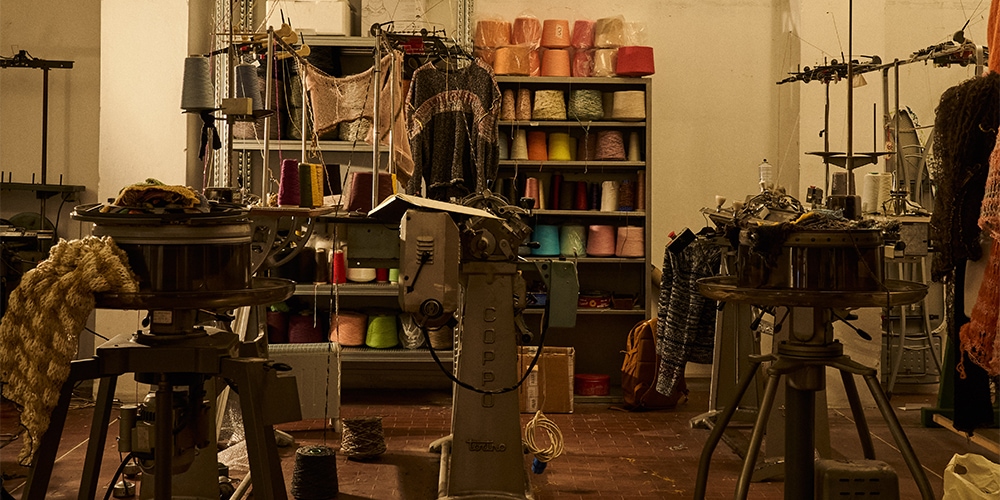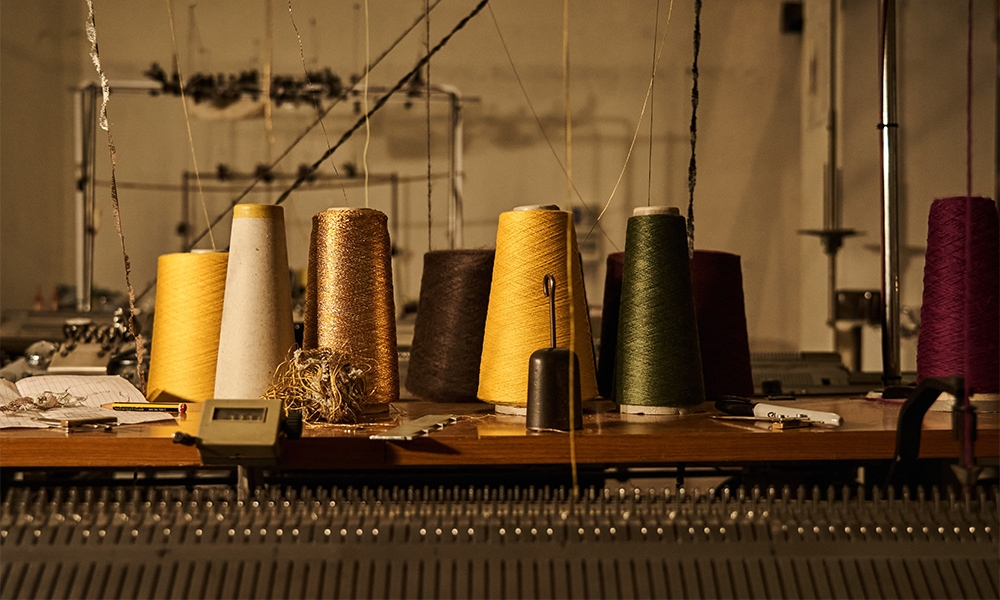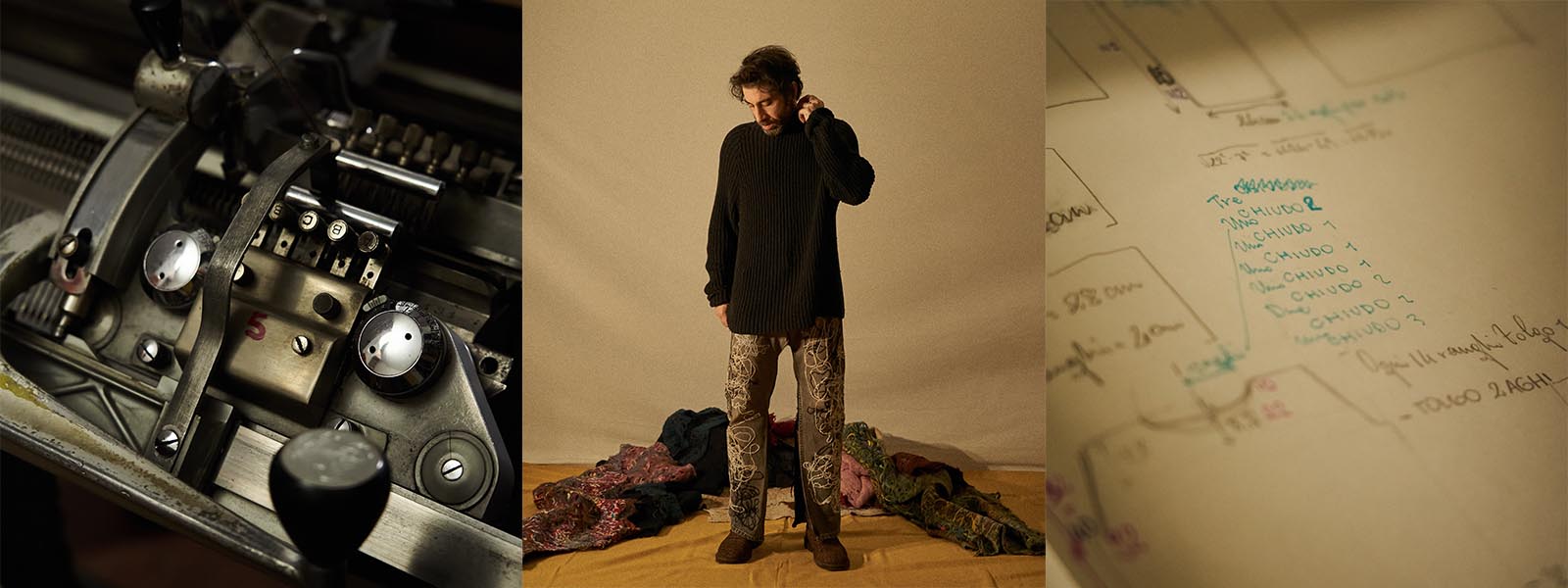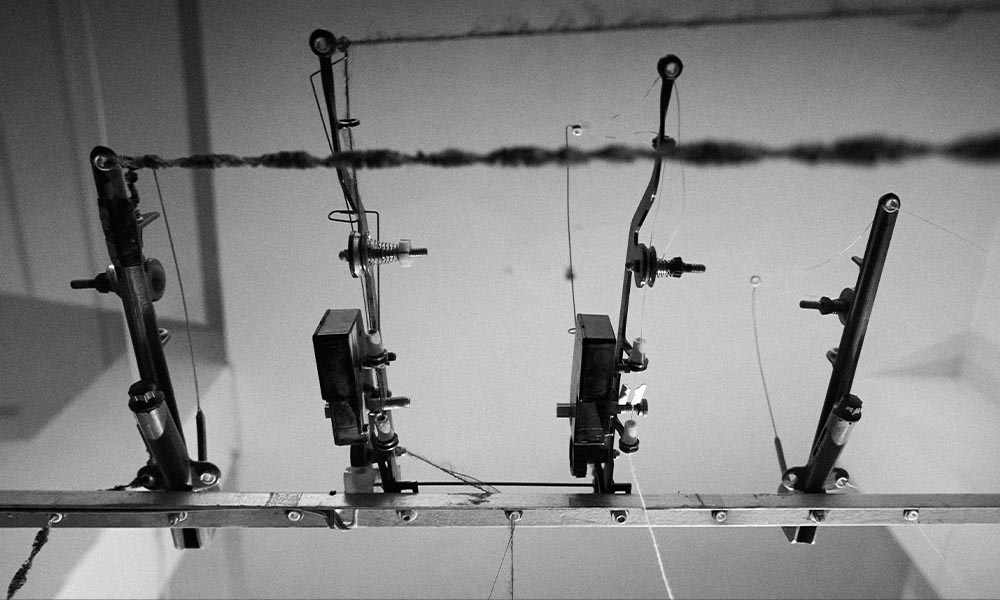
SUSTAINABLE SYMPOSIUM
VITELLI
by Barbara Maestri
What do the 80’s underground culture, a heritage of quality craftsmanship and contemporary innovation have in common? Mauro Simionato and Giulia Bortoli, Vitelli’s creative duo, have the answer. Through revolutionary fabrics, a cosmic aesthetic and challenging co-labs, their 100% Italian knitwear brand aims to refresh vintage imaginary and foster eco-friendly fashion.
Mauro and Giulia, first of all you’ve teamed up to develop a sustainable independent project. Why did you choose knitwear? And, above all, why Vitelli?
Mauro: The choice of knitwear was, for me, mainly linked with two facts. First is the fact that I met Giulia while she was studying for a master’s degree in knitwear at Milan’s Politecnico University. Second, knitwear comes from Veneto and we’re both from that region. As to the second part of your question, the name ‘Vitelli’ derives from Federico Fellini’s movie ‘I Vitelloni’, but above all from the desire to find a truly Italian name or indeed a word taken from the vocabulary of Italian-Americans – the most Italian ones in the world.
Giulia: Knitwear itself represents a break from runway fashion. It’s very technical and opens infinite worlds when those who work with it have an open vision linked with experimentation. Aiming to represent 100% Italian craftsmanship without falling into old concepts (knitwear often reeks of renewed vintage), we decided to focus on this ancient technique, while being totally open to innovation.
‘Doomboh’ is the revolutionary fabric of yours: vintage yet experimental, designed to save the environment. What’re its properties and the origin of its name?
Mauro: ‘Revolutionary fabric’ is a beautiful description, thanks! It’s unexpected, ugly and imperfect, being made of scraps, and we were inspired by Dumbo, the Disney character. We Italians are the only ones in the world to pronounce the word ‘Dumbo’ with the ‘u’ vowel that has an ‘u’ sound. In other languages, it’s pronounced with an ‘ɑ’ sound. So, we used the Italian pronunciation of that word and translated it in English phonetics, playing with the concept of ‘Doom’!
Giulia: Doomboh was born out of necessity. Wandering around companies, we saw that a lot of yarn, left over from the production process, was thrown away or forgotten on dusty shelves at the mercy of moths. Initially, the purpose was to recover the wasted yarn and reuse it with classic knitting machines, producing knitted garments with recycled yarn. Only later, we discovered that we could evolve our idea of simple sweaters, go further with the workmanship and even experiment with a brand new concept of fabric.

Generally speaking, choosing eco-friendly clothes is still an occasional behaviour rather than a constant habit. How can we learn to take more informed choices?
Mauro: In our daily life, we have to commit ourselves to pollute as little as possible. At the level of mass production and consumption, particularly in fashion, it’s not possible to produce a lot and pollute a little, with rare exceptions. So, everyone should buy from small semi-handcrafted brands, instead of multinational retail giants. At the same time, small brands should be able to remain sustainable over time and cost significantly less. In any case, if you buy high quality clothing – like Vitelli’s – you buy less products, that’ll last you longer. Buying less and better can make things work.
Giulia: Going off what Mauro said, in order to help the consumer to choose semi-artisanal brands focused on sustainability, we also have to work on the image of the product itself. Unfortunately, sustainability is often connected with an uninspired imagery, with dark autumnal colours and rough workmanship. I’m not surprised that few people choose an aesthetic of this kind. However, if the awareness of wanting to invest in a green product arises, then we have to provide the consumer with garments that are innovative and in line with the times. This is what we’ve tried to do with Doomboh.
Production takes place in Schio, Veneto – the natural habitat of Italian knitwear since the 19th century. Do you feel a sort of responsibility towards such a legacy? What’s your relationship with local people?
Mauro: The responsibility we feel towards this legacy is the very reason why, since our first season, we’ve always and only worked in the Vicentino district and, in particular, in Schio. The idea of building a bridge between us, the creative scene we’re a part of and a network of small workshops, weavers and embroiderers was and still is the main goal of Vitelli as a brand and as a proper Made in Italy project. We never wanted to use the Venetian producers, but instead collaborate with them by confronting these producers and learning from their craft.
Giulia: I agree with Mauro’s words, only through their collaboration we’re able to fully express ourselves.
‘Less waste, more cosmic’. In Vitelli’s DNA, a sustainable philosophy is blended with the 1980’s Italian cosmic movement. Why are you so fascinated by that decade?
Mauro: In terms of style and pop culture, the ‘Cosmici’ or ‘Baiosi’ was the penultimate Italian youth movement of the 80’s. The very last was the ‘Paninari’, which was against the ‘Cosmici’. The etymology itself of the two words explains our position. Both Giulia and I are more of a ‘cosmos’ than a ‘panino’ type (‘panino’ is the Italian for ‘sandwich’, E.D.). Apart from this, I believe the ‘Cosmici’ and their way of mixing with vitality and attitude the many styles that preceded them in the 70’s remain a valid portrait of Italians. Focusing on it, season after season, allows us to work on the Italian style, obviously in our own way and keeping an open discussion.

Looking at contemporary society, what subcultures stimulate your creativity?
Mauro: All those who share the attitude of Italian ‘Cosmici’. I’m interested in what’s happening in Brazil, both São Paulo and Rio, or in Lagos (Nigeria), where we’ve bonded with the Bloke brand and the Lagos Knitting Club. Also in Milan there are projects speaking to today’s cosmics, such as Spiritual Sauna, with whom we have a long history of collaborations relating to shows and performances organised in our Vitelli Area. We hope that we’ll be able to get back to work together soon.
‘We reject genres and definitions’: Vitelli is clearly committed to inclusivity. What’s your idea of a unisex look?
Mauro: I think there’s a difference between men’s and women’s clothing in the Vitelli designs. Men’s garments, such as blazers, jackets and workwear trousers, but also classic knitwear and everything that was said to be masculine, or better still is, can be interpreted in a fluid way. On the other hand, the Vitelli women’s garments evoke a strong but fairly classic femininity. Giulia, for example, never wears our women’s clothes, only men’s. When we think about creating a Vitelli collection, we keep in mind the cosmic movement in which the boys and girls of the late 70’s were free but still linked to each other.
Giulia: Men’s garments are easily adapted to the feminine world, and even the garments with a more feminine cut could easily be worn by boys, but still with some difficulties: for example, many dresses are designed by following the female silhouette in terms of flattening and adherence.
Knitwear, but also tailoring, sneakers and headwear. For your latest collections, you got in touch with other fields, collaborating with multifaceted designers and brands. What requirement do you seek in your potential partners? What would you like to experiment with in the future?
Mauro: The co-labs were often born spontaneously. By following and getting to know each other, through Instagram or other ways, you fall in love with the aesthetic and message of the other. Then, almost always, the desire to collaborate is expressed and brainstorming begins. Designing together with other creatives is one of the most stimulating moments for me. It’s one of the reasons why having your own brand is a unique and all-encompassing experience. Obviously, what’s left for us to do is a collection of bags. We’re working on it, so if you read this interview and make cool bags, just write to us!

Credits: Photo by Lorenzo Basili